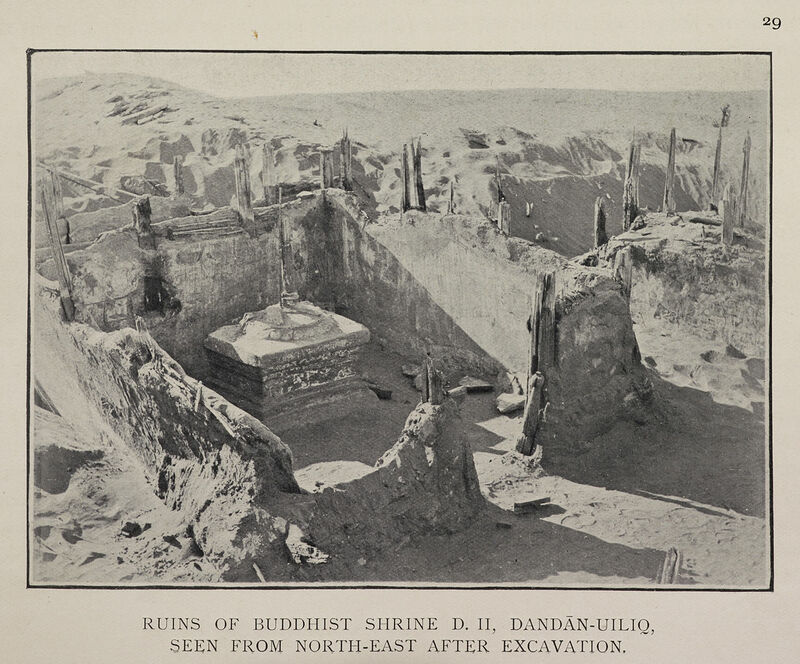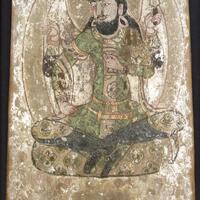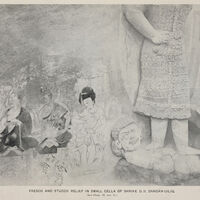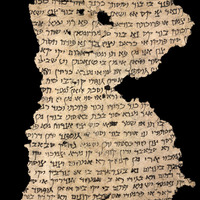Smuggling silk in Central Asia
Date:
Sixth to eighth century
Location or Findspot (Modern-Day Country):
China
Medium:
Wood
Dimensions:
Silk-smuggling plaque: 12 × 46 cm; god of silk two-sided panel: 33.5 × 21 cm
Description:
A painted wooden plaque depicts the story of how silkworm eggs and mulberry seeds to feed them were introduced into Khotan, breaking the Chinese monopoly on silk. Located east of the Sogdian lands (which also manufactured and traded silk), Khotan was an important Iranian Buddhist kingdom in Central Asia that flourished between the first and tenth centuries. The nimbed figure at the center of the plaque is a Chinese princess who smuggled the eggs and seeds in her crown; the servant at the left points to the elaborate headgear. Between them is a basket of silkworm cocoons. At the far right, another haloed figure works at a loom. The remaining figure, cross-legged and multi-armed and with a distinctive blue halo, is probably the god of silk. The princess, who may have lived in the fourth century, supposedly established a Buddhist monastery at the silk-production site.
The painted plaque was discovered at Dandan-Uiliq, now in Xinjiang Province in western China. The town was abandoned in the late eighth century (the date of the latest coins found on the site), and the plaque likely dates to a century or two before that. In the sixth century the Byzantines had a similar story about a monk smuggling silkworms from China to inaugurate the Byzantine silk industry.
The god of silk also appears on a two-sided devotional panel from Dandan-Uiliq, but here his long hair and beard make him look Iranian and not Chinese. Nevertheless, the cross-legged pose and the objects held in his multiple hands are the same as on the silk-smuggling plaque: probably a goblet and a weaver's comb and shuttle. On the reverse is a triple-headed deity from India, probably Shiva, known in Khotan as Mahesvara. Both painted plaques underscore how Khotan (and all of Central Asia) was an important part of the so-called Silk Routes; it was a crossroads of cultures, moving goods, images, and ideas between China, India, and the Iranian lands to the west.
The oasis of Dandan-Uiliq (lit. Houses of Ivory) was rediscovered in 1896. It yielded numerous wooden houses, Buddhist shrines decorated with murals and stucco reliefs, and paintings and documents on wood and paper, including an early letter in Judeo-Persian—Persian in Hebrew characters—written by a Sogdian Jewish trader around 800.
The painted plaque was discovered at Dandan-Uiliq, now in Xinjiang Province in western China. The town was abandoned in the late eighth century (the date of the latest coins found on the site), and the plaque likely dates to a century or two before that. In the sixth century the Byzantines had a similar story about a monk smuggling silkworms from China to inaugurate the Byzantine silk industry.
The god of silk also appears on a two-sided devotional panel from Dandan-Uiliq, but here his long hair and beard make him look Iranian and not Chinese. Nevertheless, the cross-legged pose and the objects held in his multiple hands are the same as on the silk-smuggling plaque: probably a goblet and a weaver's comb and shuttle. On the reverse is a triple-headed deity from India, probably Shiva, known in Khotan as Mahesvara. Both painted plaques underscore how Khotan (and all of Central Asia) was an important part of the so-called Silk Routes; it was a crossroads of cultures, moving goods, images, and ideas between China, India, and the Iranian lands to the west.
The oasis of Dandan-Uiliq (lit. Houses of Ivory) was rediscovered in 1896. It yielded numerous wooden houses, Buddhist shrines decorated with murals and stucco reliefs, and paintings and documents on wood and paper, including an early letter in Judeo-Persian—Persian in Hebrew characters—written by a Sogdian Jewish trader around 800.
Relevant Textbook Chapter(s):
3,
4
Repository and Online Resources:
• Read about the silk-smuggling plaque on the British Museum website.
• Listen to the BBC podcast, "Silk Princess Painting," from A History of the World in 100 Objects.
• Read about the two-sided votive panel on the British Museum website.
• Read about the early Judeo-Persian commercial letter on the British Library blog.
Image Credits:
British Museum; Wikimedia Commons (Aurel Stein photographs)





